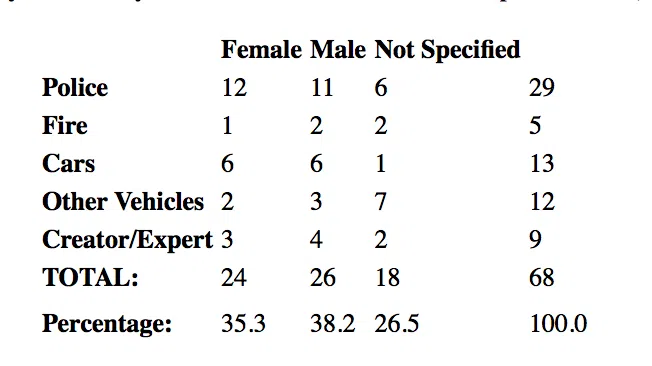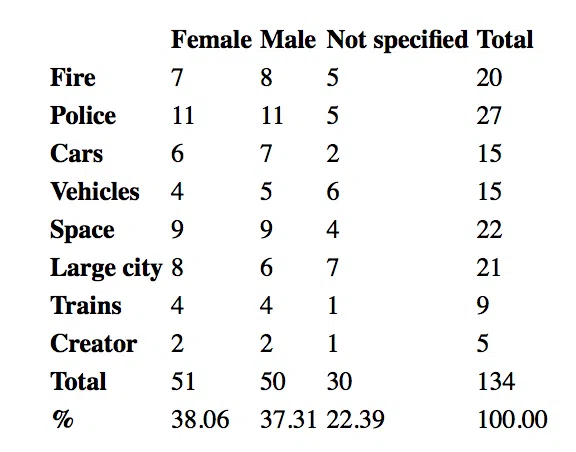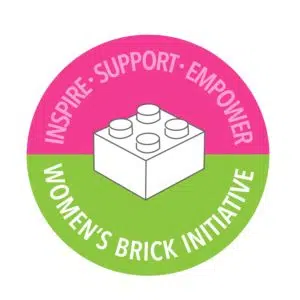Periodically Richard Jones at The Rambling Brick takes an in-depth look at gender balance in LEGO City. We love his analysis so much we use Richards work in our WBI presentations! So when Richard reached out this week and told me he had updated his research in anticipation of International Women’s Day, I jumped at the chance to reprint his work here. So without further ado lets take a look at gender balance in LEGO City for 2020.
Gender Balance in LEGO City by Richard Jones
March the 8th marks International Women’s Day, and I thought I would briefly return to my occasional analysis of Gender Balance in LEGO® City.I haven’t visited the topic for a couple of years, and was wondering if there have been significant changes here.
Methods
I looked at the raw numbers based on the first half released sets in LEGO City/Creator and Creator Expert ranges, as defined on the Brickset Database(sampled March 3 2020). Now this year’s releases do not necessarily mean ‘What’s on the Shelves in the shop’ so I also looked at a breakdown of gender in the City sets included in the current Print Catalog (January -May 2020). I will repeat the analysis for LEGO Friends.

Figures were allocated gender according to secondary sexual characteristics, based on societal stereotypes: facial hair being the main determinate for male figures; lipstick, long hair and/or printed curves for female figures, and the remainder were considered ‘non specified’ – faces were relatively plain, often associated with a hat, although some ‘short spiky haircuts’ might be as likely to be associated with males and females equally in some regions. I recognize the danger of referring to stereotypes here, but I would like to consider this in terms of how a child would relate to a given Minifigures. Typically, figures without secondary characteristics described above are as likely to be ascribe a gender by the child playing with them, most in line with how the child sees that role of that figure (in terms of social role or occupation) within its society.
Results
In this first instance, I looked at NEW sets in the City and Creator themes, as well as Creator Expert sets released in 2020. There were 71 figures released across 36 sets. The arrival of characters appearing in LEGO City Adventures also opens this analysis up to calculating the number of CHARACTERS released this year. I shall look at that shortly. This year, the City set releases were across Fire and Police; Cars (including a garage and car yard) and other vehicles. Creator included the Monster Burger truck, the Townhouse/Toy Store, and the modular Book Store.


As you can see from the data presented, when we look at the 2020 releases, including poly bags, minifigure packs and sets released, we have 35% of minifigures female, 38% male while the remaining 26% are not specified. Perhaps a bit of a decrease in female representation from 2017, when we saw 40% female representation within LEGO City and Creator/Expert in the sets released that year. However, it is pretty similar to the ‘obviously male’ rate – and a noticeable surge in the proportion of ‘not-specified.’ figures.

The breakdown of minifigure gender in the 1st half year sets released in 2020

If we modify the approach to interpret the data as we see it in the 2020 1st half year catalog – we might see a different story. This catalog does not feature creator expert, poly bags or minifigure accessory packs. BUT it does include some sets from 2019, and indeed the trains from 2018. These are the sets that children will be exposed to when they read pore over the catalogue:


Its a bit closer to the 40/40/20 spilt, particularly if we round it up to the nearest 5%. We do see a greater number of figures ‘defined’ as it were, but the balance is pretty similar between male and female figures. Of course this is a little different to what we see in LEGO Friends.

MEANWHILE, in Heart Lake City…
Historically, LEGO Friends has a bias towards female minidolls in the sets, if only because the five main characters appear in multiple sets. As such, I would like to consider the number of males appearing in Friends, as a proportion of different CHARACTERS.
When I looked at the 2020 First half year releases on Brickset, there are eleven characters featured to date. Two of these are male.

Again, I return to ‘sets in the catalogue’ breakdown to see what differences lie here. There are 21 sets listed in the first half year print catalog for Australia (excluding the cubes). There are 16 characters listed in total. Five of the 20 sets contain only one of the four male characters (Zack appears twice). As is consistent with previous years, 1 in 4 sets has a male character and a total of four in sixteen characters are male.

Collectable Minifigures Series 1-20

Lets take a quick look at the Collectable Minifigures. Historically the licensed minifigures have included around 5 or 6 female characters out of a total of 20. Even lines which one might expect to be heavy on female characters, such as Disney, maintained this level. That said, the LEGO Movie 2 saw this peak at a 9/20 split. The most recent DC Superheroes series has 5 out of sixteen figures as female characters.
Lets take a quick look at the ‘main’ collectable minifigure series over the years: Initially, there were only 3 female characters in S1-4 increasing to 5/16 in S6. Thes sets vacillate between 5 and six female characters until S19: we see an increase in female representation to 7 or 8 out of the 16 figures. Technically the rainbow bear is labelled a guy in the series listing. It would appear, based on what has been seen in S20, that we now have parity between female and male characters.

In conclusion
However we view the data, we are still well ahead of 2011, as far as gender balance is concerned. Indeed, we almost have balance in LEGO City. There are a similar number of women and men with slightly fewer non gender specific figures than we’ve seen in the past. Of course, it’s still a difference from the original minifigures, where virtually all minifigures had no specific gender. Hair design often was the only defining feature.
Of course, with so many years of predominantly male minifigure dominance, it will take some time for many collections to approach parity. But this may not be the overall goal.
Some will dismiss this article as a way of politicizing children’s play and a toy, that we associate quite dearly with our own childhood. This discussion is really looking, ultimately, at representation.
Children prefer toys that they can relate to. Girls and women make up close to 50% of the worlds population (1.018 men: 1 woman, as at March 2020). If gender defying characteristics are being used for male minifigures, then it is appropriate that such characteristics are used for females as well. Then we will create a level of balance. There are people in our society who choose to defy gender defining appearance. While this might have once been the historical norm for minifigures, it has become a a relative minority – only 23% of figures in the current catalog
If we’re going to see our daughters rise as they grow, free from the limitations place on them by historical societal expectations, then it is good to see toys reflect that goal. They can reinforce seeing women in roles that they are not necessarily associated with like leading the space program, fire chief and fire fighters, policemen, adventurers and daredevils. Indeed, LEGO City aims to inspire young builders with a variety of relatable/realistic play scenarios. Ultimately its important that the minifigure balance represents the gender balance within our society today.
Do you think LEGO has over done the gender balance? Over Done it? or got it Just Right? Why not leave your comments below, and until next time…
Play Well!
You can read more from Richard at The Rambling Brick or even better, subscribe to his blog!


1 comment
AlpineButterfly
I’ve been watching this analysis for years, it’s one of my favorites, for many years i would work hard to collect the female minifigs, I guess to see myself in minifigures.
I would be intrested to see how this would break down along race lines. I know “yellow” is supposed to be a universal race, an intention I applaud… but I’ve noticed a lack of curly, and black hair until the most recent releases. Would also love to see some culturally diverse clothing. I have worked hard to add additional skin tones in my collection. Finding brown & black figures is hard as they are only in licenced sets, and I don’t know that hollywood is the place to look for diversity. So while I understand lego’s intention with yellow people…I wonder if other ethnic groups actually see themselves in these toys. That in the end may be more important than lego’s intention.